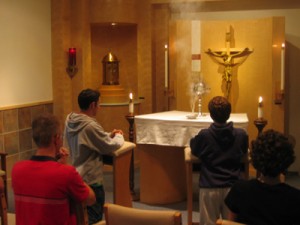
Catholic devotions are external practices such as prayers “attached to particular times or places, insignia, medals, habits or customs” that “manifest the particular relationship of the faithful with the Divine Persons, or the Blessed Virgin Mary . . . or with the Saints . . .” (Directory on Popular Piety and the Liturgy, 2001). I believe new life could be breathed into parishes and families if popular devotional prayers were practiced with great fervor and conviction because the need for affective, nonliturgical, communal prayers remains, and because it is an excellent means in and through which to pass on the Catholic faith to the next generation.
Lay Catholic devotional practices, however, started to decline in the 1950s and continued after Vatican II (1962-65) (Kelly, 2009). Theologians and social scientists have offered various explanations for this decline: growing affluence of laity, less reverence for authority, suburbanization, secularization, etc. Sociologist Melissa Wilde (2007), on the other hand, believes there is an internal ecclesial reason for the decline – an emphasis on “ecumenism” at Vatican II. All of these explanations are worth consideration, but it is worth noting, for example, that Eucharistic adoration is growing on some college campuses – and knowing what happened in the past might shed light on this practice.
Whatever the case might be, sociologically, this increase in Eucharistic adoration is promising because, as Robert Wuthnow (1999) has found, parents transmit faith to their children primarily in and through religious social rituals more so than through religious education (in particular, bed-time and meal prayers). It is bodily religious practices, and I would add “repeated or ritualized” practices that mark religion in one’s body and mind more so than theological explanations – at least for most ordinary Catholic parishioners. Sunday Mass certainly is a bodily Catholic ritual practice, but most Catholic parishioners need additional weekday religious practices to sustain their faith, and for generations those religious practices were in one sense or another devotional – such as Eucharistic adoration, the rosary, novenas, bed-time devotions, etc. And central to devotions is the bodily, ritual, doing, practicing dimension – not studying about, taking classes on, or reading about devotions. Wuthnow refers to this as a “practicing spirituality” without necessarily having a personal systematic theology to explain it. If individuals do develop a theology for their practice, it usually follows the practice – what the Church has long known as mystagogical catechesis.
This ritual theory on which Wuthnow supports his research, suggests further that “my” devotion to Mary (rosary) is “meaningful” because I “pray” or “do” the rosary. I do not necessarily “pray the rosary” because it is meaningful to me – although that certainly might be the case. The emphasis is clearly on “practicing” over “thinking.” Another sociologist, Stephen Warner, states it this way: “I do not sing sacred harp music because it is meaningful to me; it is meaningful to me because I sing it” (Warner, 2010). We could argue about the order of causation; what comes first, meaning or practice, but that should not obstruct us from emphasizing the “doing” or practicing of devotions.
Ritual theory suggests then, as does Catholic incarnational theology, that initiating ourselves and our children into Catholic devotional practices is imperative for transmitting the faith to the next generation. In other words, this transmission of faith depends as much on “doing” or “practicing” as it does on solid catechesis. If we are not praying the devotions, then I would argue the catechesis is lost on our children.
Finally, from a ritual theory perspective, parishes and schools, if they don’t already “do” this, should start practicing a particular devotion and then see if it “catches” on, and if it does to do it over and again till it is ingrained in their hearts – even known “by heart.” If a particular devotion does not catch on, try another – but start initiating devotional practices with all the gusto and energy and prayer and collective effervescence (joy) that you, as leader, can muster. Sociological research has found that most lay Catholics remember their devotional practices far more than any catechesis they ever received. Devotions, therefore, are not only means for expressing our faith but a means through which to invite others who have fallen away back, as well as, keeping many from falling away in the first place.
References:
Wuthnow, Robert. 1999. Growing Up Religious: Christians and Jews and Their Journey’s of Faith. Boston: Beacon Press.
Wilde, Melissa J. 2007. Vatican II: A Sociological Analysis of Religious Change. Princeton:PrincetonUniversity Press.
Kelly, Timothy. 2009. The Transformation of American Catholicism: The Pittsburgh Laity and the Second Vatican Council, 1950-1972. Notre Dame:University ofNotre Dame Press.
Directory on Popular Piety and the Liturgy: Principles and Guidelines. 2001. Vatican City: Congregation for Divine Worship and the Discipline of the Sacraments.